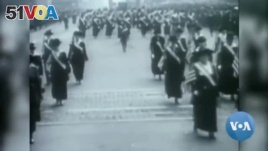17 August 2020
A little over a century ago, feminists tirelessly campaigned for women's suffrage in the United States. They organized marches and other events in hopes of increasing public support for the campaign.
One hundred years ago this month, women were finally given the right to vote through the passage of the 19th Amendment to the U.S. Constitution. The amendment was first introduced to Congress in 1878. It took more than 40 years for it to be passed and then approved by three-fourths of the states.

100 Years Since Women Gained Right to Vote
On August 18, 1920, Tennessee became the much-needed 36th state to ratify the amendment. At the time, the country had 48 states.
The fight for voting rights goes back to the country's first women's rights convention in 1848. The meeting was held at Wesleyan Methodist Church in Seneca Falls, New York.
An estimated 300 people attended the conference. One of them was abolitionist Frederick Douglass. No women of color were present.
Attendees included Elizabeth Cady Stanton. She was the lead writer of the Declaration of Sentiments, a document calling for equality with men, including the right to vote.
Today, the old building where the convention took place is part of the Women's Rights National Historic Park in Seneca Falls.
Andrea DeKoter is the park's acting superintendent. She told VOA that the Declaration of Sentiments is modeled after the U.S. Declaration of Independence. But the words — "all men are created equal" — were changed to, "all men and women are created equal."
African American men were given voting rights in 1870 through the passage of the 15th Amendment. Women continued to fight for their own suffrage. However, DeKoter said there was "racism in the women's rights movement." White suffragists did not include Black women in their movement, she said.
Martha S. Jones is a history professor at Johns Hopkins University in Maryland. She said the exclusion led Black women to "form a parallel movement within their own organizations." Jones said these included religious conferences, civil rights organizations, and antislavery groups.
Some states passed their own women's suffrage legislation. But women's rights activists wanted a national amendment.
New activists
As the lives and expectations of women were changing in the early 20th century, a new generation of young women continued the struggle. By 1916, these suffragists increased their protests. They organized marches, silent gatherings, and hunger strikes. Critics harassed and shouted at the women.
Renewed energy in the movement, along with President Woodrow Wilson's 1918 decision to support the amendment, helped lead to its passage two years later.
A century later, many women still face voter suppression, notes the League of Women Voters. This, the group says, includes "forcing discriminatory voter ID and proof-of citizenship restrictions on eligible voters, reducing polling place hours in communities of color, and illegally purging voters from the rolls."
Inequalities like these and others may be reduced through passage of the Equal Rights Amendment, or ERA, supporters say. The ERA was introduced to Congress in 1923, three years after American women gained voting rights. It was approved by the House of Representatives in 1971 and by the Senate in 1972. But it was only ratified by three-quarters of the states in January 2020 — many years after the target deadline.
Eleanor Smeal is president of the Feminist Majority Foundation. She argues that if the deadline were removed, the amendment could become a part of the Constitution.
Like women who fought for voting rights, Smeal said, "the Equal Rights Amendment is very important because it establishes that all women must be treated equally under our Constitution."
Among other things, she said, it would end discrimination in areas such as pay and education, and help prevent violence against women.
I'm Ashley Thompson.
Deborah Block reported this story for VOA News. Ashley Thompson adapted it for Learning English. George Grow was the editor.
_______________________________________________________________
Words in This Story
feminist - n. someone who believes that men and women should have equal rights and opportunities
suffrage - n. the right to vote in an election
introduce - v. to present (something) for discussion or consideration
abolitionist - n. a person who wants to stop or abolish slavery
parallel - adj. very similar and often happening at the same time
harass - v. to annoy or bother (someone) in a constant or repeated way
eligible - adj. able to be chosen for something : able to do or receive something
polling place - n. a building where people go to vote in an election
purge - v. to remove people from an area, country, organization, etc., often in a sudden or violent way
deadline - n. a date or time when something must be finished